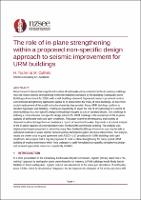| dc.contributor.author | Tocher, Hamish | |
| dc.contributor.author | Cutfield, Matthew | |
| dc.date.accessioned | 2023-02-21T01:18:00Z | |
| dc.date.available | 2023-02-21T01:18:00Z | |
| dc.date.issued | 2022-04-27 | |
| dc.identifier.uri | https://repo.nzsee.org.nz/xmlui/handle/nzsee/2463 | |
| dc.description.abstract | Recent research shows that a significant number of earthquake-prone unreinforced brick masonry buildings may not receive seismic strengthening within the deadlines mandated by the Building (Earthquake-prone Buildings) Amendment Act 2016, with at-risk buildings clustered disproportionately in provincial centres. Conventional strengthening approaches appear to be uneconomic for many of these buildings, as does from-scratch replacement of the social and cultural amenity they provide. Many URM buildings conform to standard typologies and detailing, creating an opportunity to lower the cost of strengthening for a subset of these buildings via a non-specific design methodology mapped to a set of standard details. One challenge in defining a comprehensive non-specific design scheme for URM buildings is the assessment of the in-plane capacity of perforated walls and open shopfronts. This paper examines the frequency and severity of observed in-plane damage from reconnaissance reports of recent earthquakes. It presents a structural analysis of the in-plane capacity of a representative open-fronted URM commercial building. The analysis uses displacement-based assessment to show that many New Zealand buildings of common type may be able to withstand moderate in-plane seismic demand without dedicated in-plane structural intervention. The analysis results are shown to be in good agreement with ASCE 41-17 provisions for URM buildings with open shopfronts. We propose that it may be pragmatic to omit in-plane strengthening for many typical URM building of modest dimensions which have undergone a well-formulated non-specific strengthening design and received appropriate measures competently installed. | |
| dc.language.iso | en | |
| dc.publisher | New Zealand Society for Earthquake Engineering | |
| dc.relation.ispartofseries | 2022;2 | |
| dc.subject | Communicating seismic risk and mitigation strategies | |
| dc.subject | Society, policy, and culture in understanding impacts and improving resilience | |
| dc.subject | Case studies and research supporting risk mitigation by retrofitting | |
| dc.title | The role of in-plane strengthening within a proposed non-specific design approach to seismic improvement for URM buildings | |
| dc.type | Article | |

